I DID not really want to repeat what all too many are stating at the moment, but the first couple of days on the Leicester Ring really showed us that there is a big difference in the condition of the waterways since we last cruised it four and half years ago.
Virtually every lock leaks and though the gates are not quite as bad to move as those broad lock gates on the Trent & Mersey Canal, they are worse that they were on our last trip, many no longer so well balanced and the paddles leave a lot to be desired.
Grass has been cut
The vegetation as always been rife on the Soar, both on the towpath side and off side overhanging trees, but is now somewhat worse. One good thing is that virtually all the grass however on the non-surfaced towpath has been cut—all the way into Leicester, and there are swathes of cut grass by the locks, we seeing two teams of grass cutters at work, but alas methinks it is more for the walkers and cyclists than us poor boaters.
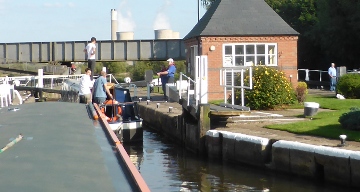 But back to the start, for only the second time in nearly 20 years we set off from Sawley on a bright Sunday sunny afternoon with no less than three volunteer lock keepers on Sawley Locks, for of course like most of the other lock keepers the one at Sawley has been replaced by volunteers—and a right mess they were making of it too. Talk about too many cooks...
But back to the start, for only the second time in nearly 20 years we set off from Sawley on a bright Sunday sunny afternoon with no less than three volunteer lock keepers on Sawley Locks, for of course like most of the other lock keepers the one at Sawley has been replaced by volunteers—and a right mess they were making of it too. Talk about too many cooks...
Remember what those at Canal & River Trust would have us believe when it first announced volunteer lock keepers? I'll read it to you: 'No permanent lock keeper will be replaced by volunteers, lock keepers are too important in the safety of the operation of the waterways.'
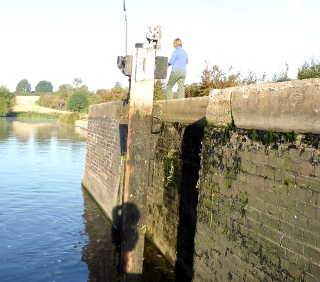 Shuffle around
Shuffle around
The first manned lock on that glorious Sunday was of course Radcliffe Lock, that took us 44 minutes—there were two plastic jobs and a small narrowboat that they seemed terrified off, with the plastic boats shuffling around to get a place, then tie up with two ropes each, coming down the lock, a lock that all of you who have used it will know has no turbulence whatsoever when being emptied. And of course they let the water out oh so slowly, mind you the ever leaking gate did help.
Then it was Zouch Cut Lock that gave trouble, as a bottom (leaking) gate would not go right back, to allow boat entry with just one gate, then would not stay closed, as too much slope. As pictured above. So it was here we go again, of the old, old method letting water in via a top gate paddle to keep it shut.
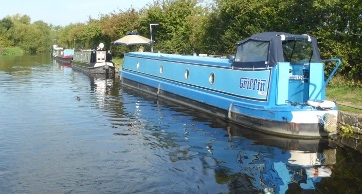 Batches
Batches
Also as other boaters have told there are more boats moored in 'batches', and at our old favourite mooring places, with no space above the weir at Kegworth were there is deep water, and no space on another favourite of ours on the piling just out of Loughborough, (pictured) the outcome of the release of more and more continuous cruiser licences. But we had no need to stop,
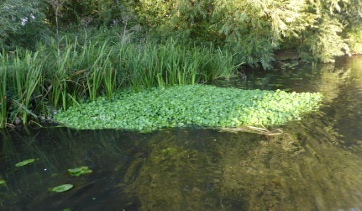 Once again Pennywort was becoming abundant, with swathes right down the Soar to Radcliffe, (pictured), though it was not as bad as it was the last time we cruised the waterway, but it had certainly spread, so it is likely it will soon be in the Trent.
Once again Pennywort was becoming abundant, with swathes right down the Soar to Radcliffe, (pictured), though it was not as bad as it was the last time we cruised the waterway, but it had certainly spread, so it is likely it will soon be in the Trent.
Evasion team
There is now new piling and mooring rings at Junction Lock on the Soar, yet ner a boat in sight, so obviously it must be one of those frequently checked by the evasion team. But also the towpath had also been upgraded to a cycle track, which perhaps was the real reason of no boats as it was a very 'fast' track towards Leicester.
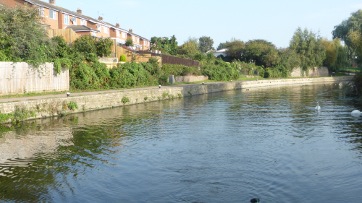 Yet Birstall visitor moorings, that we have never risked as always full, was completely empty—more of the evasion team? Birstall was another lock that had deteriorated, with extremely stiff gates, though the paddles were easy enough.
Yet Birstall visitor moorings, that we have never risked as always full, was completely empty—more of the evasion team? Birstall was another lock that had deteriorated, with extremely stiff gates, though the paddles were easy enough.
We had a little trouble at Birstall Lock as there was the boat Paradise Café well and truly moored right in the centre of the lock moorings—and seemingly permanent. Of course it was there to catch the walkers and cyclists, but surely it could have been at the end of the mooring, which would have made it easier for boaters. Here's a picture.
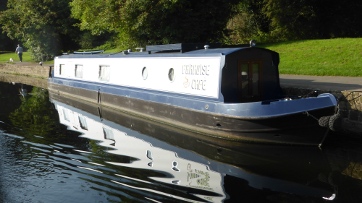 This is the area of those peculiar river water level gauges, were one will be on green, the next on red and the next on orange. It is also the area of lots of vegetation with miles after miles of it with the banks abounding with nettles—and Japanese Knotweed, that Jan tells has roots growing down to tremendous lengths, that knocks thousands of pound off building sites.
This is the area of those peculiar river water level gauges, were one will be on green, the next on red and the next on orange. It is also the area of lots of vegetation with miles after miles of it with the banks abounding with nettles—and Japanese Knotweed, that Jan tells has roots growing down to tremendous lengths, that knocks thousands of pound off building sites.
Even though the towpath, and when a cycle track, has the grass by its side mown, it is obvious that neither the towpath side vegetation or the off side trees have had any attention whatsoever for a very long time, and cruising into Leicester it is clearly shown that it is the walkers and cyclists who are important, for little or no money has been spent on making life easier for the boaters, as the following photograph—on a canalised section, clearly shows.
 Another bad one
Another bad one
As we came nearer to Leicester the state of the locks deteriorated with us helping to get an hire boat out of North Lock, as by the time the fella on the far side had dropped his paddle having made sure he had drained the lock, by the time he had crossed the gate, it wouldn't open, though two people were pulling and pushing— such was the leakage of the top gates. So he had to go back and make sure both bottom paddles were fully open before the gate could be opened.
It was at North Lock we met Niffty Fifty with the boater telling us he came down Foxton Flight on Sunday, and he was the only boat on the flight though there were loads of gongoozlers and four volunteer lock keepers. He also told that St Mary's Lock was difficult to operate as it was broke—so we have that to look forward to.
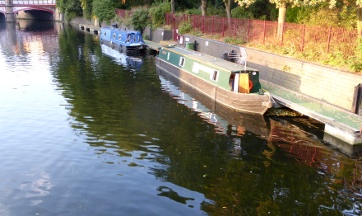 Those days of dashing from the Lakes at Syston to the moorings at Kilby Bridge or vice versa have long gone, and as we have always admired those pontoon moorings in Leicester at West Bridge, we decided on a stay, and with rubbish bins and a locked gate to the nearby Castle Park it was uneventful.
Those days of dashing from the Lakes at Syston to the moorings at Kilby Bridge or vice versa have long gone, and as we have always admired those pontoon moorings in Leicester at West Bridge, we decided on a stay, and with rubbish bins and a locked gate to the nearby Castle Park it was uneventful.
Not so bad now
For many years the Soar through Leicester had a terrible reputation for vandals, many boaters telling of stone throwing youths, and even the locked pontoon moorings were known to be pelted with missiles from the nearby footbridge. Aylestone Park and the entire area through Wigston was strictly taboo when the schools were out. But things have obviously changed, shown by the all too often paddle locks having been completely removed, even those at at Aylestone Park having no paddle locks, and not a single beer can anywhere.
Victor Swift
